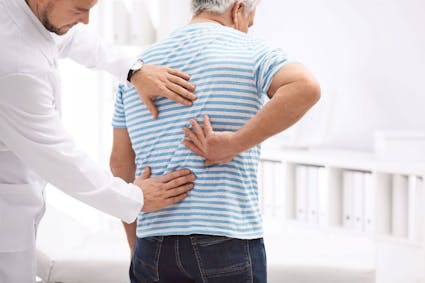
Spinal stenosis can occur when one or more bony openings (foramina) within the spinal canal (where the spinal cord runs down the center) and/or in the intervertebral foramina where spinal nerves exit the spinal canal narrows and reduces space for the nerves. This can cause pressure on the spinal cord and compress nerve roots.
There are 3 general types of spinal stenosis:
- Foraminal stenosis (lateral stenosis) - compression or inflammation of a spinal nerve due to the narrowing of one or more intervertebral foramen (the bony openings on each side of spinal vertebrae through which nerve roots pass)
- Central canal stenosis - compression or inflammation of the spinal cord due to the narrowing of the vertebral foramen (the bony opening in the center of the vertebra that protects the spinal cord as it runs down the spinal canal)
- Far-lateral stenosis - narrowing of areas surrounding nerve roots once they have exited from a foramen (typically caused by spine degeneration or injury)
Where within the spine can spinal stenosis occur?
Central canal stenosis can occur anywhere in any of the vertebral foramina throughout the spine, but typically occurs in the neck (cervical) or lower back (lumbar). Foraminal stenosis can happen anywhere in the spine. It's also possible for someone to have both central canal stenosis and foraminal stenosis or foraminal stenosis in two or more levels of the spine (tandem stenosis).
What causes spinal stenosis?
Spinal stenosis is typically due to osteoarthritis and age-related wear and tear. However, it can also be brought on by an injury, bone diseases (such as Paget disease), spinal tumors and thickening of certain spinal ligaments. Improper lifting technique is a common cause of injury-induced spinal stenosis because it can damage discs and even move vertebrae out of alignment, which would reduce the amount of space for nerves to pass through.
What are the symptoms of spinal stenosis?
Symptoms of spinal stenosis can include:
- Dull or radiating electric-like pain that runs from the spine through the shoulders and arms or down through the buttocks and into the leg, sometimes even down into the foot or feet (sciatica). Sometimes, the pain is more localized within the spine, such as the neck or lower back. On rare occasions, there may be weakness or numbness with little or no pain.
- Neurological dysfunctions resulting from spinal cord compression, such as numbness, tingling and cramping in the arms or legs (myelopathy).
- Severe spinal cord compression (cauda equina syndrome) may cause bowel and/or bladder dysfunction.
In most cases, spinal stenosis can be effectively managed with conservative treatments. Unfortunately, most back pain and sciatica treatments only mask the symptoms and at best provide temporary relief. However, physical therapy is a proven treatment method that provides long-lasting results for most types of back pain, including spinal stenosis. If you are suffering with any of the above-mentioned signs or symptoms in the neck, middle back, or lower back, chances are, our physical therapists can help.
Conditions We have Successfully Rehabilitated:
- Neck Pain
- Sprains & Strains
- Stiffness
- Spine Arthritis
- Pinched Nerves
- Thoracic Outlet Syndrome
- Neck Weakness
- Postural Syndromes
- Herniated Discs
- Post-surgical Rehab
- Low Back Pain
- Lumbago
- Stenosis
- Sciatica
- Bulging Discs
- Degenerative Disc Disease
- Spondylosis
- Spondylolisthesis
- Piriformis Syndrome
- Sacroiliac (SI) Dysfunction
Care Starts with a Thorough Evaluation
Our spine specialists start with an intensive examination and assessment of your condition. A treatment plan is then developed that is based on your specific needs. We then provide you with a clear, easy-to -understand explanation of how we can help you manage your pain.
We Then Develop a Personalized Treatment Plan for You
Treatment often consists of gentle, hands-on techniques which often result in immediate relief of spine-related pain. Since our spine care is all natural, there are little to no side effects.
We frequently include the following procedures in your treatment program:
- Manual therapy (hands-on treatment)
- A customized therapeutic exercise program
- Extensive patient education about your condition
Our Evidence-Based Approach
There are three components to each and every spine rehabilitation program:
- The current best evidence - new scientific research is being published on a regular basis that suggests you should see a physical therapist first.
- Our clinical experience - we’ve treated a variety of spine diagnoses over the years. Clinical experience allows us to make good decisions about the type of treatment you should received.
- Your treatment goals - of course we consider your goals when developing a treatment plan.
We Can Accommodate You
We understand that a comprehensive treatment plan is about more than just pain relief. We know you have a busy schedule, insurance coverage may be a challenge, and you have to deal with work and family responsibilities. We will work with you and your specific circumstances.
Give us a call today to learn more. We look forward to helping you out.
